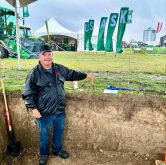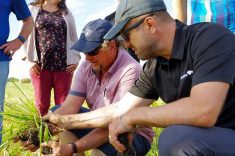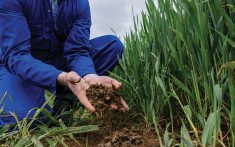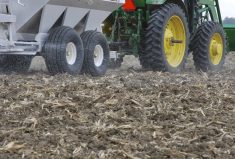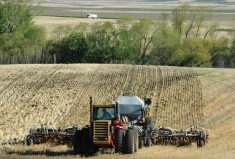Under a blazing sun, Senator Rob Black shared insights from the recently released soil study entitled “Critical Ground.”
“Soil is critical and essential to life; we must do all we can to preserve it,” Black stated.

Why it matters: The United Nations reported that in 26 years, 90 per cent of soil could face degradation so severe that food can’t be grown.
The senator spoke metres away from the Ontario Soil and Crop Improvement Association’s soil pit, which displayed the challenges and benefits of soil health during each day of Canada’s Outdoor Farm Show Sept. 10-12.
Read Also

Mazergroup’s Bob Mazer dies
Mazergroup’s Bob Mazer, who helped grow his family’s company into a string of farm equipment dealerships and the main dealer for New Holland machinery in Saskatchewan and Manitoba, died July 6 from cancer.
“My biggest fear is that we’re going to wake up someday and realize that we can’t feed our province, let alone the country or the two billion more that we have in the world (in 30 years),” said Black. “That’s a scary thing.”
The report, authored by the Standing Senate Committee on Agriculture and Forestry, makes 25 recommendations but three rank highest on Black’s wish list: designating soil as a strategic national resource; creating a national soil database; and appointing a national soil advocate.
Designating soil as a resource is important and easy to do, suggested Black, adding that it must be accompanied by a long-term strategy for protection and conservation, including regularly reviewed targets, timelines and provisions. He said the report addresses a glaring lack of soil health data.
On Sept. 11, the federal government announced a $6.9 million commitment over five years to Dalhousie University’s Faculty of Agriculture research project to modernize Canada’s soil-data infrastructure.

“Given the size of Canada, the costs of carrying out national-scale surveys of our soil resources is economically unsustainable,” said Brandon Heung, associate professor and project lead, in a media release. “We must explore ways to make the most out of the data we have collected in the past representing tens of millions of taxpayers’ dollars.”
The project is expected to consolidate data from partners, use machine learning to fill in data gaps, develop a national soil data inventory and a Canadian soil spectral library. It is also expected to provide information to reduce the cost of soil analysis by leveraging advances in soil sensing.
Additionally, a research team from Dalhousie’s School for Resource and Environmental Studies will endeavour to understand the behavioural and legal motivations or barriers to data sharing to help inform government policy recommendations on the issue. Private entities, including individual producers and corporations, hold much of Canada’s soil data.
Creation of a high-resolution national map of critical soil properties will track soil-based greenhouse gas sequestration and emissions. Data will be provided via the Canadian Soil Data Portal, a visual online platform of data and soil maps available to farmers, foresters, students and policymakers.
Heung said to ensure the project’s legacy, Dalhousie has partnered with economists at the universities of Alberta, Saskatchewan and Carleton to provide an economic valuation of and an investment case for the long-term maintenance of soil data infrastructure.

The Senate report highlights the relationship between water management and soil health, the need for data-driven decisions and support for data capture, whether it’s a snapshot or ongoing monitoring, said Heather White, communications coordinator at Soils at Guelph.
“It certainly highlights the need for a connecting piece between the research and the practitioners,” she said, adding Soils at Guelph is a conduit for information.
“Soil health is a suite of principles being applied, as opposed to a particular practice, which is a good way to think about how to manage the diversity of soil.”

It’s easy to forget about soil’s importance or take it for granted, said White, but the report puts soil health in the crosshairs.
Black agreed.
“Healthy soil is the foundation of our agriculture sector and, by extension, our economy and our environment. It’s the very first ingredient in all the food we eat.”
Black said the soil study revealed 20 million contaminated sites globally. On average there are 1.72 contaminated sites per 100,000, with mining, oil and gas industries posing significant health risks. The report also noted an increase in pharmaceutical contaminants.
“Soil is often taken for granted, yet it’s our most vital resource,” said Black. “It supports our food systems, regulates water, sustains plant and animal life and plays a crucial and critical role in mitigating climate change.”

He urged people to use the report to advance soil health advocacy and research.
While speaking with the Canadian Society of Soil Scientists in Vancouver in June, he learned they were using the report for funding applications only six days after its release.
“That’s pretty cool,” he said. “We can push and shove them, collectively as organizations, provincially and nationally, but my hope is they’ll see the value in what we did.”
The report was tabled in the Senate on June 13. The government has until Nov. 10 to respond.








